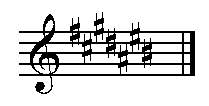Key Signatures
Key signatures are the sharps of flats next to the treble clef and time signature. Sharps and flats raise or lower a note by one semi-

# (Sharps) = Father Christmas Gets Daddy An Electric Blanket.

b (Flats) = Blanket Explodes And Daddy Gets Cold Feet.
We will start with working out the key signature of a written piece of music. To avoid complications at this stage, we will presume that it is a major key. We will deal with minor keys later.
Naming a # key
Look at the last sharp in a key signature then go up a semitone. That is the key.
e.g. 3 #’s, last sharp = G# therefore up a semitone will be A major.
Naming a b key
This formula works with two or more flats (one flat is F major). Go back one flat from the right of the key signature and that is your key. e.g. 3 b’s, last b = Ab. So going back one flat, will be Eb making Eb Major.
Obviously, this system of working out keys works for written pieces of music. In exams you will be asked to write or play a scale so you will need to work out the key signature. Decide whether or not it is a flat or sharp key. e.g. Bb Major is obviously flat. Another way to tell is; all keys with natural notes, except F and C, have sharps. e.g. D, E, G, A and B majors. Once this is worked out, follow the appropriate method below.
Flat Keys
Say the flat formula, ‘Blanket Explodes’ etc. until you reach the name of the key. Then say one more. E.g. Ab major, Blanket (Bb) Explodes (Eb) And (Ab) then add one -
Sharp Keys
Say the sharp formula ‘Father Christmas…etc. until you reach a semitone below the key name.
e.g. D major-
Minor Keys
Minor keys share the same key signature as the relative major key. The difference between the two keys are that in the written music of the minor key, there will usually be accidentals that raise the seventh and sometimes the sixth degree of the scale. (More on the minor scale later). Minor keys are three semitones lower than the relative major key (so each key signature can have two answers; major & minor). Care is needed when working out the relative major. For example, C minor up 3 semitones = Db, D, Eb. NOT C#, D, D# because the key signature of D# major would have a C# in it, and as we are looking for C minor it doesn’t work. Be prepared to enharmonically change the note. (Enharmonic is to use an alternative name for the same note), eg D# is the same as Eb.
Once you have found the relative major, work out the key signature as in the previous procedures. Try following the example.
Name the key of F# minor.
i Find the relative major by going up three semitones. F#-
ii A major is a sharp key (Obviously F# minor is as well) so go down one semitone to find the last sharp in the key signature. A-
iii Run through the sharp formula until you reach G. Father Christmas Gets= F#, C# and G#.
In F# minor, the sixth and seventh degrees are D and E so in the written music, these may be raised.

